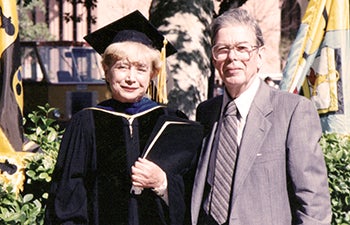In Memoriam: Harriet Herta Forster, 97
Harriet Herta Forster, professor emerita of physics and astronomy at USC Dornsife, an internationally known figure in the field of experimental nuclear physics, has died. She was 97.
Forster died peacefully of natural causes at a Los Angeles nursing home on Sept. 28.
Hans Bozler, professor and chair of physics and astronomy, said Forster’s subatomic particle research garnered the physics department international acclaim. She arrived in 1948 as an accomplished physicist specializing in nuclear physics and later focused on undergraduate teaching in the classroom and her duties as the department’s director of undergraduate affairs. She retired in 1987.
“Herta loved being at USC because after her retirement, she often visited both the department and the USC Emeriti Center, where she took an active role,” Bozler said.
Born Herta Förster on June 20, 1917, in Vienna, Austria, Forster was the elder child of Karl Förster, a haberdasher, and his wife Olga Frankfurter. Early on, Forster showed academic promise. From age 14 onward, she tutored children to supplement her family’s income.
In October 1938, following the March annexation of Austria by Germany’s ruling Nazi party, Forster saved her younger brother Erich’s life. In testimony she gave in 1996 to the USC Shoah Foundation Institute’s Visual History Archive, Forster recounted how, after hearing that Jewish children at Erich’s Viennese high school were in imminent danger, she set off in a taxi to find her brother.
She arrived in the nick of time. Black vans were already lined up outside the school to transport the school’s Jewish students to concentration camps. Many children were already inside the vans. When Forster found her brother still inside the building, she took him home in the taxi. Erich was sent to England in 1939 and eventually to Australia, where he survived the war.
In 1939, Forster escaped Austria, traveling to Glasgow, Scotland, to stay with a family who had volunteered to employ a Jewish girl as a nanny. After working briefly in a nursery school, Forster immigrated to the United States in 1940, arriving in New York. There, she found work as a nanny and in a bakery. In 1941, she married Kurt Engelberg, an Austrian physicist she knew from Vienna.
Forster’s parents, who had remained in Vienna, were taken by the Nazis in 1942 and perished in the Treblinka death camp in Poland.
In 1943, Forster and her husband moved to California, where he had joined the U.S. military. She began her studies at the University of California, Berkeley, earning her doctorate in physics in 1948. She arrived at USC Dornsife in the Fall of that year, becoming professor of physics in 1964. She served as chair from 1962 to 1964, heading the department’s Nuclear Accelerator Program for several years.

Professor Harriet Forster and husband, physicist George “John” Garlick attend a graduation at the USC University Park campus. Photo courtesy of Soshana Svendsen.
Forster’s warmth and kindness made a lasting impression on faculty and students.
“She did an excellent job because of her patient manner and empathy for students,” Bozler said.
Richard Thompson, associate professor of physics and astronomy, remembered Forster’s strong teaching skills with large undergraduate classes and her engaging personality.
In 1952, Forster and Engelberg divorced and in 1977, Forster married physicist George “John” Garlick.
Robin Shakeshaft, professor of physics and astronomy, remembered Forster’s kindness when he arrived at USC in 1981.
“Herta was a warm and generous person,” Shakeshaft said. “She made it painless for me to learn the ropes. In my first months in Los Angeles, she often invited me to join her and her partner John for dinner, or to hear the Los Angeles Symphony or to brunch at her home with some of her many friends.”
Forster was one of few women physicists of her time. During her tenure at USC, she published more than 62 papers on nuclear physics and received numerous honors. She mentored 16 doctoral candidates through their Ph.D. programs, participating with them in many national and international conferences.
She was elected a fellow of the American Physical Society and was awarded the 1956-57 Founders Fellowship by the American Association of University Women. In 1981, she won a Women of Achievement Award. She also led the physics and astronomy department’s undergraduate program until her retirement at age 70.
In 1988, she was awarded the USC Faculty Lifetime Achievement Award. This honor recognizes eminent careers and notable contributions to the university, the profession and the community.
Forster was fond of animals, particularly her beloved Irish setters, golden retrievers and cats. She enjoyed classical music, skiing, gardening as well as walking in the Santa Monica Mountains.
“Herta was dear friends with my grandparents and my mother, and a devoted godmother to me,” said Forster’s goddaughter Soshana Svendsen, who was by her side when she died. “We were very close and lived together when I was a young child and a graduate student.
“It is thanks to Herta that my mother and later I passed our college mathematics and physics courses. In addition to being a brilliant physicist, I will remember Herta for being a great hostess and for spoiling all of her pets. Most of all, I will always remember the love that I saw in Herta’s eyes and her angelic smile.”
Forster is survived by her nephews, Matthias and Frank Forster.
A funeral service will take place at 2 p.m., Mon., Oct. 6 at Woodlawn Cemetery, 1847 14th Street, Santa Monica, California, 90404.